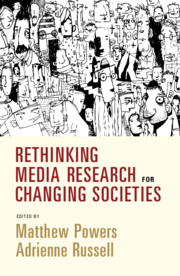Book contents
- Rethinking Media Research for Changing Societies
- Communication, Society and Politics
- Rethinking Media Research for Changing Societies
- Copyright page
- Contents
- Figure
- Contributors
- Acknowledgments
- 1 Introduction
- Part I Living in a Datafied World
- Part II Journalism in Times of Change
- Part III Media and Problems of Inclusion
- Part IV Engagement with and through Media
- Part V The Role of Scholars
- Other Books in the Series (continued from page ii)
- References
1 - Introduction
Published online by Cambridge University Press: 18 September 2020
- Rethinking Media Research for Changing Societies
- Communication, Society and Politics
- Rethinking Media Research for Changing Societies
- Copyright page
- Contents
- Figure
- Contributors
- Acknowledgments
- 1 Introduction
- Part I Living in a Datafied World
- Part II Journalism in Times of Change
- Part III Media and Problems of Inclusion
- Part IV Engagement with and through Media
- Part V The Role of Scholars
- Other Books in the Series (continued from page ii)
- References
Summary
This chapter summarizes the book’s aim, which is to explore how scholars working at the intersections of journalism, politics, and activism make sense of and relate to some of the most pressing issues concerning contemporary developments in media and public life. Matthew Powers and Adrienne Russell describe recurrent questions that confront scholars of media and public life, and then summarize the core themes explored in the volume, which are living in a datafied world, journalism in times of change, media and problems of inclusion, engagement with and through media, and the role of scholars.
Keywords
- Type
- Chapter
- Information
- Rethinking Media Research for Changing Societies , pp. 1 - 24Publisher: Cambridge University PressPrint publication year: 2020
References
- 1
- Cited by



